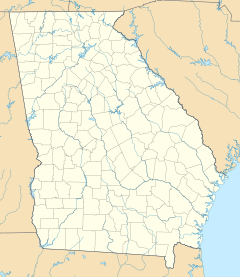
Savannah College of Art and Design (SCAD) is a private art school with locations in Savannah, Georgia; Atlanta, Georgia; and Lacoste, France. It was founded in 1978 to provide degrees in programs not yet offered in the southeast of the United States. The university enrolls more than 16,000 students from across the United States and around the world with international students comprising up to 17 percent of the student population. SCAD is accredited by the Southern Association of Colleges and Schools Commission on Colleges and other professional accrediting bodies.

Romanesque Revival is a style of building employed beginning in the mid-19th century inspired by the 11th- and 12th-century Romanesque architecture. Unlike the historic Romanesque style, Romanesque Revival buildings tended to feature more simplified arches and windows than their historic counterparts.

Heins & LaFarge was a New York City–based architectural firm founded by Philadelphia-born architect George Lewis Heins (1860–1907) and Christopher Grant LaFarge (1862–1938), the eldest son of the artist John La Farge. They were the architects for the original Romanesque-Byzantine east end and crossing of the Cathedral of St. John the Divine in Manhattan, and for the original Astor Court buildings of the Bronx Zoo, which formed a complete ensemble reflecting the aesthetic of the City Beautiful movement. Heins & LaFarge provided the architecture and details for the Interborough Rapid Transit Company, the first precursor to the New York City Subway.
John S. Norris was an American architect.

The North Kowloon Magistracy is a historic building and former Magistrate's Court located at No. 292, Tai Po Road, Shek Kip Mei, Kowloon, Hong Kong.
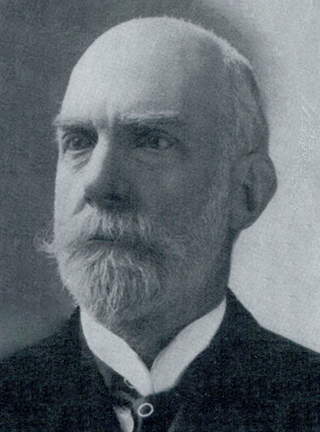
William Gibbons Preston was an American architect who practiced during the last third of the nineteenth century and in the first decade of the twentieth. Educated at Harvard University and the École des Beaux-Arts in Paris, he was active in Boston, New York, Rhode Island, Ohio, New Brunswick and Savannah, Georgia, where he was brought by George Johnson Baldwin to design the Chatham County courthouse. Preston stayed in Savannah for several years during which time designed the original Desoto Hotel, the Savannah Volunteer Guards Armory and 20 other distinguished public buildings and private homes. He began his professional career working for his father, the builder and architect Jonathan Preston (1801–1888), upon his return to the United States from the École in 1861, and was the sole practitioner in the office from the time his father retired c. 1875 until he took John Kahlmeyer as a partner in about 1885.

Stephen Decatur Button was an American architect and a pioneer in the use of metal-frame construction for masonry buildings. He designed commercial buildings, schools and churches in Philadelphia, Pennsylvania, and Camden, New Jersey; and more than 30 buildings in Cape May, New Jersey.
Paula Wallace is president and co-founder of the Savannah College of Art and Design (SCAD).

Hotel Indigo Atlanta Midtown is a historic building in midtown Atlanta, Georgia. Designed by Atlanta-based architectural firm Pringle and Smith in 1925, the brick building is located on Peachtree Street, across from the Fox Theatre. It has been listed on the National Register of Historic Places since 2006, and, in 2022, is a member of Historic Hotels of America.
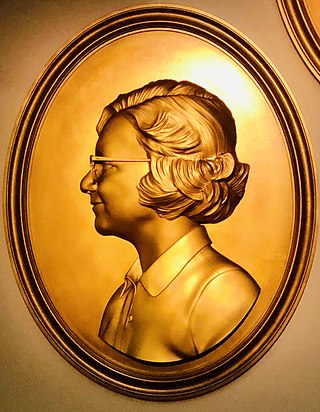
Clermont Huger Lee was a landscape architect from Savannah, Georgia, most known for her work designing gardens and parks for historical landmarks in the state. Specifically, Lee is known for her designs such as the Juliette Gordon Low Birthplace, Isaiah Davenport House and Owens-Thomas House. Lee assisted in founding of the Georgia State Board of Landscape Architects which serves as a licensing board for landscape architects throughout Georgia. She is considered one of the first women to establish their own private architecture practice in Georgia and was inducted into the Georgia Women of Achievement in 2017 and Savannah College of Art and Design's Savannah Women of Vision on February 14, 2020. SCAD honors Lee with a gold relief in its Arnold hall.
George E. Dickey (1840–1900) was an architect who worked in the United States and Canada in the 1800s.

Savannah City Hall is the seat of government for the city of Savannah, Georgia, United States. Designed by architect Hyman Witcover, the building was built between 1904 and 1905 and opened the following year. It is a contributing property to the Savannah Historic District.

Madison Square is one of the 22 squares of Savannah, Georgia, United States. It is located in the fourth row of the city's five rows of squares, on Bull Street and Macon Street, and was laid out in 1837. It is south of Chippewa Square, west of Lafayette Square, north of Monterey Square and east of Pulaski Square. The square is named for James Madison, fourth president of the United States. The oldest building on the square is the Sorrel–Weed House, at 6 West Harris Street, which dates to 1840.
Mary Lane Morrison was an American writer, historian and preservationist. She was the curator of the Georgia Historical Society, a member of the National Society of the Colonial Dames of America in the state of Georgia and was a director in The Victorian Society, founded in 1966. She also wrote John S. Norris: Architect in Savannah, on the architectural work of John S. Norris, and edited Historic Savannah: A Survey of Significant Buildings in the Historic and Victorian Districts of Savannah, Georgia.
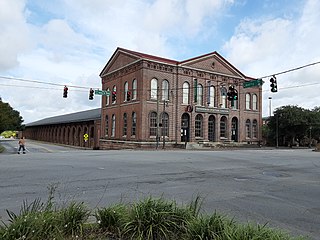
Carl August Schwaab, commonly known as Augustus Schwaab, was a German-American architect and civil engineer. He was principally a designer of commercial architecture, best known for his work in Savannah, Georgia, where he worked for around fifty years.

Kiah Hall is a building in Savannah, Georgia, United States. Located on Martin Luther King Jr. Boulevard. Regarded as "one of the finest examples of Greek Revival architecture in Georgia", it is one of the original 1856 buildings of the country's only intact Antebellum Period railroad facility. Formerly named the Gray Building, of Savannah's Central of Georgia Railroad depot, it was designated a National Historic Landmark in 1976. It is now home of the Savannah College of Art and Design (SCAD) Museum of Art.

Drayton Street is a prominent street in Savannah, Georgia, United States. Located between Bull Street to the west and Abercorn Street to the east, it runs for about 2 miles (3.2 km) from East Bay Street in the north to East Victory Drive in the south. It is named for Ann Drayton, a member of a noted family in Charleston, South Carolina, who had lent four sawyers to assist colonists in building one of the first homes in Savannah. The street is one-way (northbound). Its northern section passes through the Savannah Historic District, a National Historic Landmark District.
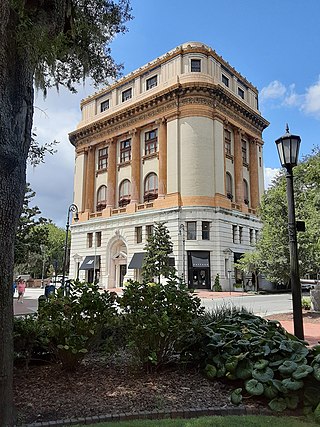
Savannah Masonic Center is a historic building at 341 Bull Street in downtown Savannah, Georgia, United States. Standing in the southwestern corner of Madison Square, it was constructed between 1913 and 1923, to a design by Hyman Witcover, previously the architect of Savannah City Hall. Today it is known as Gryphon, and is part of the Savannah College of Art and Design (SCAD).
510 East St. Julian Street, also known as the Odingsells House, is a building in Savannah, Georgia, United States. It is located in the northwestern civic block of Washington Square and was built in 1797. Built as a home for Major Charles Odingsells, a native of South Carolina, it is now part of the Savannah Historic District and is the oldest building in Washington Square.
Christian Sottile is an American architect and urban designer who is professor at the Savannah College of Art and Design. He is the principal of Sottile & Sottile, an urban design and architectural firm based in Savannah, Georgia. Sottile's work focuses on civic design and master planning, urban analysis, and community-wide engagement with an emphasis on historic research.

